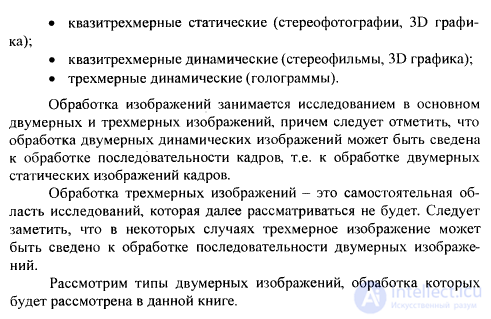Lecture



1. halftone – filtration – shrinking — sharpening, defining boundaries — quantization and discretization
2. color - change in the density and visibility of one of the channels, ????
(addition - Characteristics of the main types of images and levels of their processing.)
The main type of input data in such a system are digital images of the earth's surface, obtained from various types of imaging equipment. It can be
- multi-zone images obtained from space and aircraft
scanning systems;
- panchromatic scanner images;
- digitized spectrally combined multi-zone space and
aerial photographs;
- digitized spectral space and aerial photographs;
- digitized panchromatic aerospace images;
- radar images.
1. Normalization includes procedures that eliminate the main types of distortions of the source data.
2. Visualization and comprehensive data analysis. At this stage, the analysis of the informativeness of the available data from the point of view of the task and the choice of the principle of decomposition of the recognition system are made. If there are several images in the surveyed area, they are spatially combined (reduced to a single coordinate system). Contrast raising procedures are usually used for visual analysis (stretching a non-zero interval of brightness values over the entire dynamic range)
3. Based on a comprehensive data analysis , a general scheme for solving the problem is formed. The scheme includes the main set of classification procedures, the sequence of their application, a list of input and output data and auxiliary procedures for their processing and analysis.
4. Feature extraction is an interactive process involving a series of automatic video conversion procedures. In recognition systems based on the classification of image pixels, it is very important to choose the number of classes in the coordinate system of features. If the selected number of classes is significantly less than the number of objects on the Earth's surface differing in these dimensions, classification errors may be unacceptably high. To select the required number of source classes in such systems, an uncontrolled classification and image segmentation are used [4,13,14,23]. With a large number of measurements, signs to reduce the dimension of the problem is applied correlation and factor analysis of data. When recognizing by integral features in an image coordinate system, it is often important to enhance certain structural and textural features. In these cases, as an auxiliary, low-frequency and high-frequency filtering procedures and various operators are usually used to underline geo-indication features.
5. Classification is the main recognition unit for the problem being solved, although separate recognition procedures may be present at the feature extraction stage and at the post-classification processing stage.
In computer vision, segmentation is the process of dividing a digital image into several segments (many pixels, also called super pixels). The goal of segmentation is to simplify and / or change the representation of the image so that it is easier and easier to analyze. [1] Image segmentation is usually used to highlight objects and borders (lines, curves, etc.) in images. More precisely, image segmentation is the process of assigning such labels to each pixel of an image that pixels with the same labels have common visual characteristics.
The result of image segmentation is a set of segments that together cover the entire image, or a set of contours extracted from the image (see Border Selection). All pixels in a segment are similar in some characteristic or computed property, for example, in color, brightness or texture.
Comments
To leave a comment
Methods and means of computer information technology
Terms: Methods and means of computer information technology